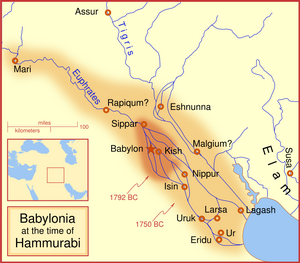Sippar
| Author:Laxman Burdak, IFS (R) |

Sippar was an ancient Near Eastern Sumerian and later Babylonian city on the east bank of the Euphrates river.[1] It was probably ancient city Hipparenum located in Mesopotamia mentioned by Pliny.[2]
Variants
- Sumerian: 𒌓𒄒𒉣𒆠, Zimbir
Location
Its tell is located at the site of modern Tell Abu Habbah near Yusufiyah in Iraq's Baghdad Governorate, some 69 km north of Babylon and 30 km southwest of Baghdad. The city's ancient name, Sippar, could also refer to its sister city, Sippar-Amnanum (located at the modern site of Tell ed-Der); a more specific designation for the city here referred to as Sippar was Sippar-Yahrurum.[3]
Jat clans
History
Despite the fact that thousands of cuneiform clay tablets have been recovered at the site, relatively little is known about the history of Sippar. As was often the case in Mesopotamia, it was part of a pair of cities, separated by a river. Sippar was on the east side of the Euphrates, while its sister city, Sippar-Amnanum (modern Tell ed-Der), was on the west.
While pottery finds indicate that the site of Sippar was in use as early as the Uruk period, substantial occupation MacGinnis, John, Jon McGinnis, and Cornelia Wunsch. The arrows of the sun: armed forces in Sippar in the first millennium BC. Islet-Verlag, 2012 ISBN 9783980846653only in the Early Dynastic Period of the 3rd millennium BC, the Old Babylonian period of the 2nd millennium BC, and the Neo-Babylonian time of the 1st millennium BC. Lesser levels of use continued into the time of the Achaemenid, Seleucid and Parthian Empires.[4]
Sippar was the cult site of the sun god (Sumerian Utu, Akkadian Shamash) and the home of his temple E-babbara(𒂍𒌓𒌓𒊏,means "white house").
During early Babylonian dynasties, Sippar was the production center of wool. The Code of Hammurabi stele was probably erected at Sippar. Shamash was the god of justice, and he is depicted handing authority to the king in the image at the top of the stele.[5]A closely related motif occurs on some cylinder seals of the Old Babylonian period.[6] By the end of the 19th century BC, Sippar was producing some of the finest Old Babylonian cylinder seals.[7]
Sippar has been suggested as the location of the Biblical Sepharvaim in the Old Testament, which alludes to the two parts of the city in its dual form.[8]
References
- ↑ Sayce, Archibald Henry (1911). "Sippara" . In Chisholm, Hugh (ed.). Encyclopædia Britannica. Vol. 25 (11th ed.). Cambridge University Press. p. 151.
- ↑ Natural History by Pliny Book VI/Chapter 30
- ↑ "Sippar". The Oxford Encyclopedia of Archaeology in the Near East (1 ed.). Oxford University Press. 1997-01-01. doi:10.1093/acref/9780195065121.001.0001. ISBN 978-0-19-506512-1.
- ↑ MacGinnis, John, Jon McGinnis, and Cornelia Wunsch. The arrows of the sun: armed forces in Sippar in the first millennium BC. Islet-Verlag, 2012 ISBN 9783980846653
- ↑ https://www.louvre.fr/en/oeuvre-notices/law-code-hammurabi-king-babylon "Law Code of Hammurabi, king of Babylon", Louvre
- ↑ British Museum. Department of Western Asiatic Antiquities (1962). Catalogue of the Western Asiatic seals in the British Museum. D. J. Wiseman, Dominique Collon, Edith Porada, Parvine H. Merrillees, T. C. Mitchell, A. D. H. Bivar. London: Trustees of the British Museum. ISBN 0-7141-1104-X. OCLC 329699.
- ↑ Collon, Dominique (2005). First impressions : cylinder seals in the ancient Near East ([Rev. ed.] ed.). London: British Museum Press. ISBN 0-7141-1136-8. OCLC 63186269.
- ↑ G. R. Driver, Geographical Problems, Eretz Israel, vol. 5, pp. 18-20, 1958
Back to Jat Places in Iraq

